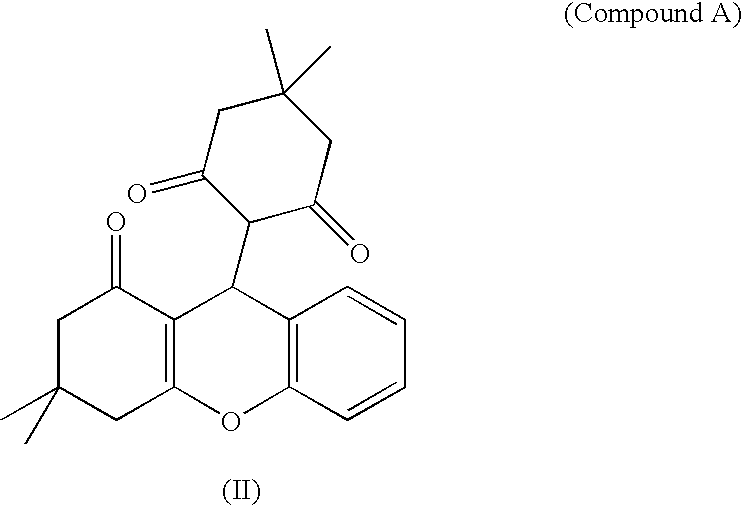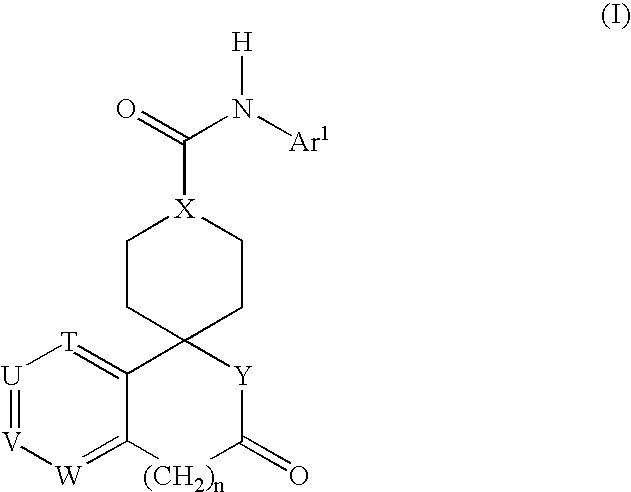Combination therapy for the treatment of hypertension
a combination therapy and hypertension technology, applied in the field of conjugated therapy for the treatment of hypertension, can solve the problems of increased risk of stroke, aneurysm, heart failure, kidney damage, etc., and achieve the effects of reducing weight, preventing cardiac hypertrophy, and improving the treatment and/or prevention of cardiac hypertrophy
- Summary
- Abstract
- Description
- Claims
- Application Information
AI Technical Summary
Benefits of technology
Problems solved by technology
Method used
Image
Examples
example 1
[0611] In vivo study for combination therapy with a NPY5 antagonist and an anti-hypertensive agent (effect on obesity / food intake) and blood pressure.
[0612] DIO rats are treated simultaneously with an effective dose of a NPY5 antagonist and an effective dose of an anti-hypertensive agent.
[0613] Male spontaneously hypertensive rats (SHR) and age- and sex-matched WKY normotensive rats are used. These animals are obtained from Harlan at 4 weeks of age and maintained on standard rodent chow, Purina Rat Chow (no. 5012; St. Louis, Mo.). They are kept in an animal room which is maintained at 23±2° C. temperature, 55±15% relative humidity and on a 12-hr light-dark cycle (7:00-19:00) during a acclimatization period of 1 week. After one week they are switched to a medium high fat chow to induce obesity, (diet 12451, Research Diets, Inc. New Brunswick, N.J.). Animals are housed individually housed and are given free access to chow and tap water. Food and body weight are measured. After 6 wee...
example 2
[0615] In vivo study for combination therapy with a NPY5 antagonist and an anti-hypertensive agent (effect on obesity / food intake) and blood pressure (effect on Cardiac Hypertrophy and Left Ventricular Hypertrophy).
[0616] Male spontaneously hypertensive rats (SHR) and age- and sex-matched WKY normotensive rats are used. These animals are obtained from Harlan at 4 weeks of age and maintained on standard rodent chow, Purina Rat Chow (no. 5012; St. Louis, Mo.). They are kept in an animal room which is maintained at 23±2° C. temperature, 55±15% relative humidity and on a 12-hr light-dark cycle (7:00-19:00) during a acclimatization period of 1 week. After one week they are switched to a medium high fat chow to induce obesity, (diet 12451, Research Diets, Inc. New Brunswick, N.J.). Animals are individually housed and are given free access to chow and tap water. Food and body weight are measured. After 2 weeks, the animals on the high fat diet have a greater body weight and greater adipos...
example 3
[0618] Human study for combination therapy with a NPY5 antagonist and an anti-hypertensive agent to treat obesity and to treat hypertension
Materials and Methods
[0619] 800 people with a BMI≧30 are advised to diet and increase their physical activity. After a two-week placebo run-in period, which includes a standardized program of diet, physical activity, and lifestyle changes, the patients are randomized into 4 treatment groups: placebo; an effective dose of a NPY5 antagonist, such as 1000 mg of Compound A; an effective dose of an anti-hypertensive agent such as enalapril; and an effective dose of the NPY5 antagonist plus an effective dose of the anti-hypertensive agent. The NPY5 antagonist is given once or more per day, as previously determined to be effective. The antihypertensive is given once or more per day, as previously determined to be effective. Patients are treated for 6 months, body weights and blood pressure are measured biweekly, and appetite, hunger, satiety are meas...
PUM
 Login to View More
Login to View More Abstract
Description
Claims
Application Information
 Login to View More
Login to View More - R&D
- Intellectual Property
- Life Sciences
- Materials
- Tech Scout
- Unparalleled Data Quality
- Higher Quality Content
- 60% Fewer Hallucinations
Browse by: Latest US Patents, China's latest patents, Technical Efficacy Thesaurus, Application Domain, Technology Topic, Popular Technical Reports.
© 2025 PatSnap. All rights reserved.Legal|Privacy policy|Modern Slavery Act Transparency Statement|Sitemap|About US| Contact US: help@patsnap.com



